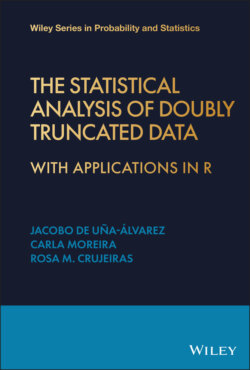The Statistical Analysis of Doubly Truncated Data

Реклама. ООО «ЛитРес», ИНН: 7719571260.
Оглавление
Prof Carla Moreira. The Statistical Analysis of Doubly Truncated Data
Table of Contents
List of Tables
List of Illustrations
Guide
Pages
WILEY SERIES IN PROBABILITY AND STATISTICS
The Statistical Analysis of Doubly Truncated Data: With Applications in R
Preface
List of Abbreviations
Notation
1 Introduction. 1.1 Random Truncation
1.2 One‐sided Truncation. 1.2.1 Left‐truncation
1.2.2 Right‐truncation
1.2.3 Truncation vs. Censoring
1.3 Double Truncation
1.4 Real Data Examples
1.4.1 Childhood Cancer Data
1.4.2 AIDS Blood Transfusion Data
1.4.3 Equipment‐ S Rounded Failure Time Data
1.4.4 Quasar Data
1.4.5 Parkinson's Disease Data
1.4.6 Acute Coronary Syndrome Data
References
2 One‐Sample Problems
2.1 Nonparametric Estimation of a Distribution Function
2.1.1 The NPMLE
2.1.2 Numerical Algorithms for Computing the NPMLE
First Efron–Petrosian algorithm
Second Efron–Petrosian algorithm
Shen's algorithm
2.1.3 Theoretical Properties of the NPMLE
2.1.4 Standard Errors and Confidence Limits
2.2 Semiparametric and Parametric Approaches
2.2.1 Semiparametric Approach
2.2.2 Parametric Approach
2.3 R Code for the Examples
2.3.1 Code for Example 2.1.8
2.3.2 Code for Examples 2.1.11 and 2.1.13
2.3.3 Code for Example 2.1.14
2.3.4 Code for Example 2.1.15
2.3.5 Code for Example 2.1.22
2.3.6 Code for Example 2.2.6
2.3.7 Code for Example 2.2.8
References
3 Smoothing Methods
3.1 Some Background in Kernel Estimation
3.2 Estimating the Density Function
3.3 Asymptotic Properties
3.4 Data‐driven Bandwidth Selection
3.4.1 Normal Reference Bandwidth Selection
3.4.2 Plug‐in Bandwidth Selection
3.4.3 Least‐squares Cross‐validation Bandwidth Selection
3.4.4 Smoothed Bootstrap Bandwidth Selection
3.4.5 Bandwidth Selectors in Practice
3.5 Further Issues in Kernel Density Estimation
3.6 Estimating the Hazard Function
3.7 R Code for the Examples
3.7.1 Code for Example 3.2.1
3.7.2 Code for Examples 3.3.4 and 3.3.5
3.7.3 Code for Examples 3.4.2 and 3.4.3
3.7.4 Code for Example 3.5.1
3.7.5 Code for Example 3.6.4
3.7.6 Code for Example 3.6.5
References
4 Regression Analysis
4.1 Observational Bias in Regression
4.2 Proportional Hazards Regression
4.3 Accelerated Failure Time Regression
4.4 Nonparametric Regression
4.5 R Code for the Examples
4.5.1 Code for Example 4.1.1
4.5.2 Code for Example 4.1.4
4.5.3 Code for Example 4.2.4
4.5.4 Code for Example 4.3.2
4.5.5 Code for Example 4.4.2
References
5 Further Topics
5.1 Two‐Sample Problems
5.2 Competing Risks
5.2.1 Cumulative Incidences
5.2.2 Regression Models for Competing Risks
5.3 Testing for Quasi‐independence
5.4 Dependent Truncation
5.5 R Code for the Examples
5.5.1 Code for Example 5.1.3
5.5.2 Code for Example 5.2.4
5.5.3 Code for Example 5.2.6
5.5.4 Code for Example 5.3.1
5.5.5 Code for Example 5.4.3
References
A Packages and Functions in R
A.1 Computing the NPMLE and Standard Errors
A.2 Assessing the Existence and Uniqueness of the NPMLE
A.3 Semiparametric and Parametric Estimation
A.4 Kernel Estimation
A.5 Regression Analysis
A.6 Competing Risks
A.7 Simulating Data
A.8 Testing Quasi‐independence
A.9 Dependent Truncation
References
Index
WILEY END USER LICENSE AGREEMENT
Отрывок из книги
Established by Walter A. Shewhart and Samuel S. Wilks
Editors: David J. Balding, Noel A. C. Cressie, Garrett M. Fitzmaurice, Geof H. Givens, Geert Molenberghs, David W. Scott, Adrian F. M. Smith, Ruey S. Tsay
.....
Kalbfleish and Lawless (1989) reported 494 cases of transfusion‐related AIDS, corresponding to individuals diagnosed prior to 1 July 1986 (). The variable of ultimate interest is the induction or incubation time, which is the time elapsed from HIV infection to AIDS. Importantly, HIV was unknown before 1982 (); this implies that cases developing AIDS prior to this date were not reported. Let denote the time from HIV infection to 1 July 1986 (in months), and introduce ; then, due to the interval sampling, only triplets satisfying were observed (Bilker and Wang, 1996). We restrict our analysis to the cases with consistent data, for which the infection could be attributed to a single transfusion or a short series of transfusions. This dataset is fully reported in Kalbfleish and Lawless (1989), p. 361.
The observed values of range from 0.5 to 89 (months), while ranges from to 45.5. This suggests that the lower limit of the support of is about , while the upper limit of the support of is about 99.5. As discussed in Chapter 2, in such a case the distribution of the incubation time is identifiable on the interval (months). The AIDS Blood Transfusion Data also includes information on the age of the individual at infection; see Table 1.2.
.....